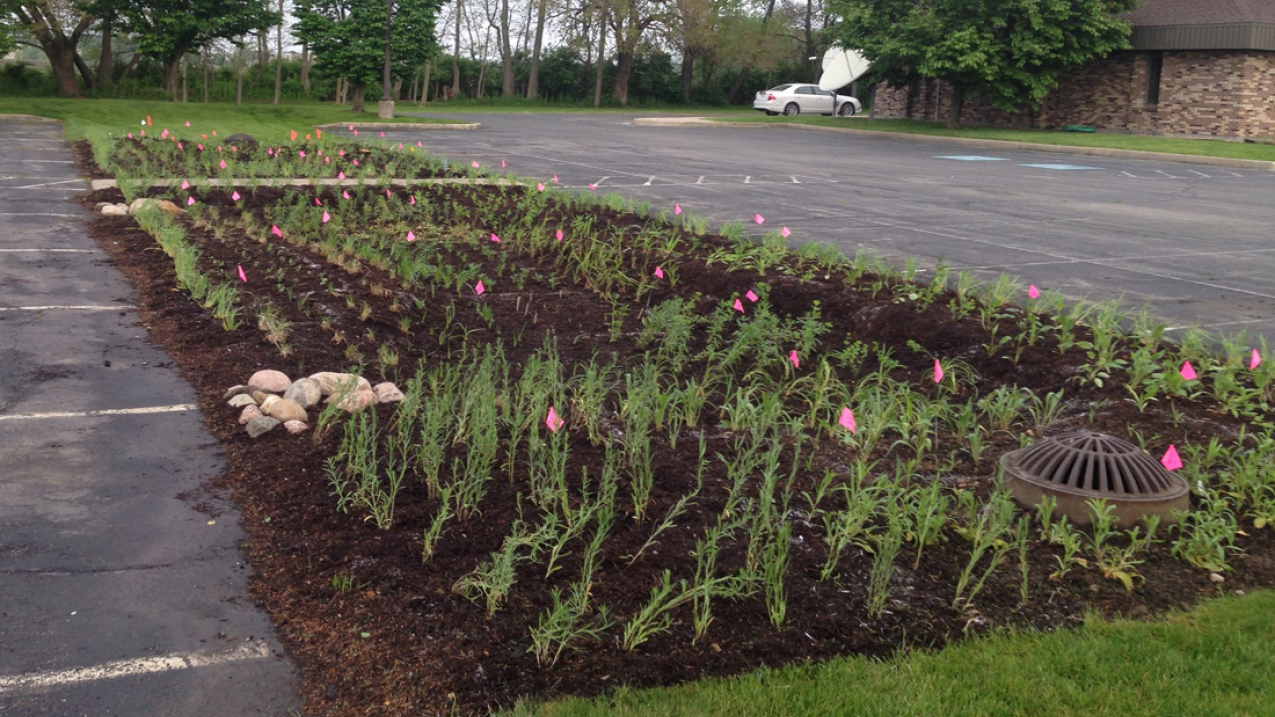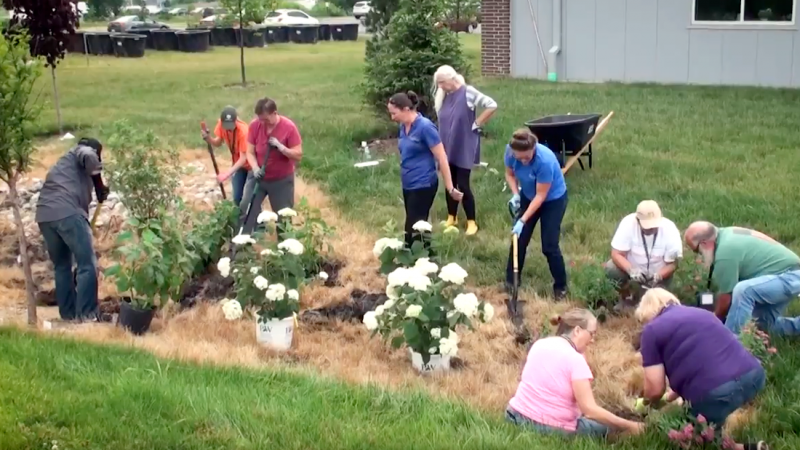During a downpour, rainwater hits pavement and flows into drains, picking up pollutants like oil, fertilizers, and road salts along the way. These pollutants can flow into nearby water bodies, where they can harm wildlife, make swimming and boating unsafe, or even contaminate drinking water.

Building a rain garden near impervious surfaces like asphalt and concrete in parking lots and driveways can help absorb stormwater runoff and reduce flooding. Pictured is the Rainscaping Education Program demonstration garden in Tippecanoe County Extension Office, Indiana. (Image credit: Purdue Rainscaping Education Program and Illinois-Indiana Sea Grant)
Urban runoff is a particular concern in Indiana, where urban areas are expanding offsite link and the risk of winter flooding offsite link is expected to increase over the coming decades. On a search for solutions, Illinois-Indiana Sea Grant and Purdue Extension are teaching residents the art and science of rainscaping. By learning how to design and build their own rain gardens, communities can help reduce flooding while protecting water quality in their neighborhoods and surrounding waterways.
Through the Purdue Rainscaping Education Program offsite link, a multidisciplinary “rainscaping team” has published a curriculum, led several state-wide workshops through 2019, and contributed to a rain garden app, all designed to teach communities and residents around Indiana how to use sustainable landscaping.
“Our multidisciplinary rainscaping program covers landscape practices, such as rain gardens directing stormwater to be absorbed by plants and soils,” said Kara Salazar, assistant program leader and extension specialist for sustainable communities at Illinois-Indiana Sea Grant and Purdue Extension. Rain gardens allow rainwater to soak into the ground, where pollutants are filtered by plant roots.
The curriculum — which has undergone extensive evaluation, improvements, and external peer reviews since pilot testing in 2015-16 — includes hands-on activities, interactive discussions, and field trips to community rainscaping projects. Participants learn about the benefits of rain gardens and how to design and maintain a garden for their space.

The program has facilitated workshops throughout Indiana since 2016. In 2018 alone, the rainscaping team conducted four workshops in Steuben, Lake, Boone, and Warrick counties for 51 participants. These workshops give community members and leaders the knowledge and resources they need to implement rainscaping in residential or small public spaces. Extension specialists teach master gardeners, landscape and stormwater professionals, and agency staff members how to promote community awareness and education for rain garden planning, installation, and maintenance. Additionally, introductory education presentations have provided more than 400 Indianians with information on the benefits of rainscaping and how to get started designing and maintaining rain gardens since the program began in 2016.
At these community workshops, participants use what they’ve learned by working together to create a demonstration rain garden in a public space. Custom interpretive signs are installed with each demonstration to educate the community. Participants have reported that they are using program resources to launch broader rain garden education programs in their own cities and towns by offering rain garden installations, tours, education programs to assist residents with their own gardens, and exhibitor booths.
“The value in the program lies in how it offers an alternative type of garden that can be beautiful as well as serve a purpose,” said Nikky Witkowski, a Purdue Extension educator in Lake County who has hosted the rainscaping education program there multiple times. Rain gardens installed as part of training workshops have the capacity to reduce runoff by a combined 319,720 gallons per year. Rain gardens that have been designed, facilitated or installed by participants or their partners will reduce runoff even more. This reduction in flow and associated pollution can improve water quality.
Illinois-Indiana Sea Grant offsite link is a part of University of Illinois Extension and Purdue University Extension.
Earlier versions of this story were featured in the Fiscal Year 2019 NOAA Education Accomplishments Report and an article offsite link by Illinois-Indiana Sea Grant.



